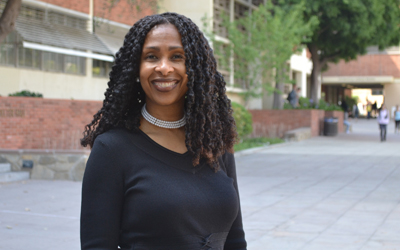2015 HARRY M. SHOWMAN PRIZE
The Showman Prize is awarded to one undergraduate and one graduate student. The prize recognizes students who have effectively communicated the achievements, research, results or social significance of any aspect of engineering.
2015 Showman Prize Graduate Student
Audrey Pool O’Neal, Ph.D., Mechanical Engineering
O’Neal was an engineer at General Motors, where she worked for 10 years. The company sent her to UCLA to earn a master’s degree, but instead of returning, she became intrigued with emerging smart materials and continued on as a doctoral student. O’Neal is also the associate director for undergraduate programs at UCLA’s Center for Excellence in Engineering and Diversity (CEED). Her graduate advisor was Professor Adrienne Lavine, director of the Modeling of Complex Thermal Systems Laboratory.
What is the name of your dissertation and what is it about?
My dissertation title is “The Effect of Particle Size and Processing on the Properties of a Barium Titanate Polymer Composite.” In layman’s terms, our objective was to create a composite material that could serve as a structural capacitor. It can store and discharge significant amounts of electricity while subject to realistic static and dynamic loads, like vibrations or impacts. This research has military and automotive applications.
How did you get interested in that topic?
I took a smart materials class with Professor Gregory Carman and he introduced me to barium titanate. I was looking for a thesis topic at the time, and Professor Carman made it so interesting to me that I knew I wanted to work with it and collaborate with his lab in some capacity.
The Showman Prize recognizes communication of research, and I understand you worked with undergraduates on your research. What did you do for them, and what did they do for you?
I had the privilege of working with 11 undergraduate students and two high school students while completing my dissertation. I’d like to think that I helped them learn the scientific method and helped introduce them to the excitement of discovery and exploration that comes with original research. In turn, they gave me a passion to do the work. Seeing engineering principles come to life through their eyes was infectious. I was very fortunate to see two of the undergraduate researchers pursue advanced degrees in engineering, and eight of them won local and national awards for the research that we accomplished together. They have definitely given me more than I have given them and I am very grateful.
You also work with the Center for Excellence in Engineering and Diversity (CEED). What is your role there and what has been most rewarding about it?
I am the associate director for undergraduate programs in CEED. In this role, I have the opportunity to work with an amazing team of colleagues and serve as co-instructor for the Introduction to Engineering Disciplines course, as well as to direct CEED’s undergraduate research program. The most rewarding part is watching freshmen come into our program and graduate a few years later. The time seems to fly, yet the transformation of the student is remarkable. They learn to be engineers, leaders, and professionals while we watch. It doesn’t get much better than that!
What’s next for you?
Working with the undergraduate students in research has shown me that I want to teach. In the immediate future, I plan to work part-time with CEED while pursuing an instructor or lecturer position.

